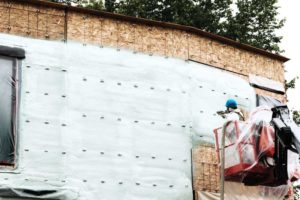Revolutionizing sustainability with HFO-blown spray foam

HFO-blown spray foam insulation, on the other hand, provides a robust solution to these challenges. When correctly installed, this material creates a highly effective moisture barrier. Unlike cellulose and fibreglass, HFO-blown spray foam insulation has very low water absorption and can dry easily after a flood. In fact, closed-cell spray foam is rated as a Class 5 material by the Federal Emergency Management Agency (FEMA); it is the only insulation product with the highest classification for flood resistant materials. This means in the event of a leak or flood, the insulation itself remains unaffected, eliminating the need for costly repairs or replacement.
The esthetic and practical advantages of spray foam insulation
Along with its superior performance as an insulant and moisture barrier, spray foam insulation offers distinct esthetics and practical benefits. Its properties allow it to serve not only as a high-performing insulation solution, but also offer the freedom of design.
The insulation is often applied to the exterior walls of a building, enhancing the structure’s energy efficiency, and is then it is finished with an attractive, ventilated facade. When using spray foam insulation in this way, its characteristics present several advantages.
From a practical standpoint, the flexibility of spray foam insulation is a significant benefit. Its ability to conform to any shape or space enables it to effectively insulate irregularly shaped areas, around obstructions, or in tight spaces where traditional insulation materials might struggle.
Further, the air-sealing property and continuity of spray foam insulation results in a higher performing building envelope. This not only enhances the final appearance, but also reduces drafts, increasing the building’s comfort and efficiency.
The moisture barrier function of spray foam insulation also plays a critical role. By effectively preventing water intrusion, it can protect the wall assembly from water damage, ensuring the building’s structure and materials remains unblemished over time. From an esthetic perspective, using spray foam insulation offers architects and designers a canvas for creativity, allowing for a wide range of design possibilities.
Case studies
Understanding the benefits of HFO-blown spray foam insulation is further enhanced by examining its use in real-world settings. Two projects: Liva Mirabel and Maison des Ainés, serve as excellent case studies for this purpose. Both are senior living buildings that prioritized green building practices and sustainability while focusing on delivering an energy-efficient and comfortable living environment for residents.


